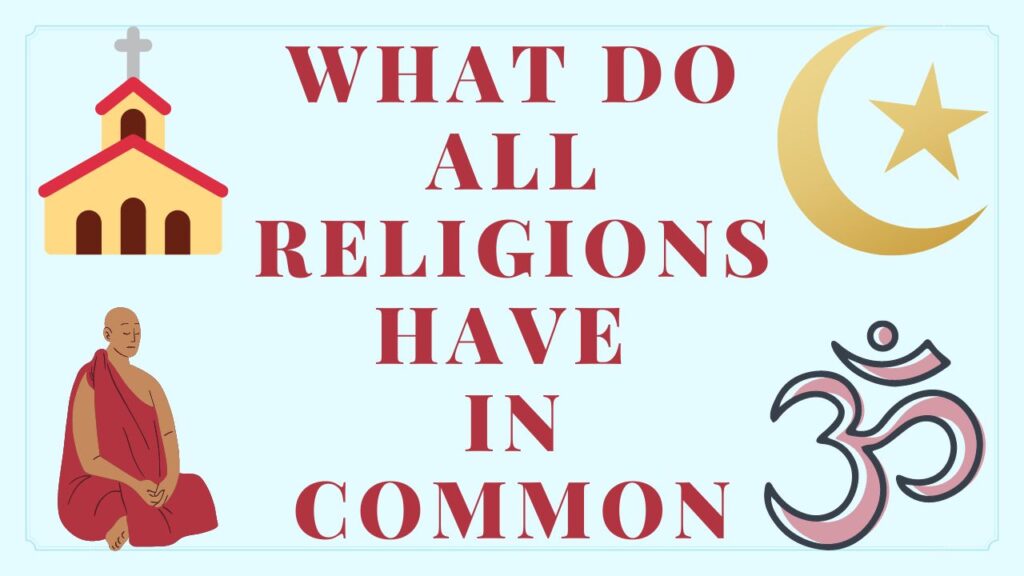
Contents
What Do All Religions Have in Common ?
Religion has long been an integral component of human societies. Although they may appear disparate at first glance, closer inspection reveals common threads which unify nearly all religious traditions – providing insight into our quest for meaning, purpose and connection with divinity. We will examine some fundamental characteristics which unite religions across cultural, geographical and historical boundaries in this exploration.
The Search for the Divine
Religion provides us with the framework for searching out a Higher Power or Transcendent Reality that gives meaning and purpose in this universe, be it God, gods, deities or universal energy – providing a framework to connect to this Divine essence as part of human need to make sense of reality and find purposeful living in life. Religion offers this path forward!
Moral and Ethical Framework:
All religions provide their followers with a moral and ethical code as a framework to guide their behavior, often including guidelines promoting compassion, empathy, justice and kindness while discouraging harmful actions. These ethical standards may appear in religious teachings or scriptures or oral traditions as blueprints for leading an upright lifestyle.
Rituals and Worship:
Rituals and worship play an integral role in religious practice around the globe, whether through praying, attending ceremonies, or engaging in meditation practices. Rituals allow followers to express their devotion, gratitude and reverence towards divinity while creating an experience shared among followers; creating community while strengthening spiritual bonds among followers alike.
Sacred Texts and Teachings:
Religious traditions place great significance on sacred texts that contain their core teachings, narratives and wisdom for everyday use. From Christianity’s Bible and Quran to Islam’s Quran and Hinduism’s Vedas – sacred texts provide moral guidance as well as answers to existential queries and provide historical records that help shape community identity.
Foster Sense of Community:
Religion fosters a sense of community among its adherents. Places of worship such as churches, temples, mosques and synagogues serve as meeting places where believers come together to practice their religion together and support each other during joyful or trying times. Religion offers individuals both emotional support as well as emotional community within its structure that fosters this communal aspect and provides social network support during both happy and difficult times.
Unraveling Life’s Mysteries:
Religion offers explanations and narratives that provide comfort in times of profound uncertainty; questions surrounding purpose, suffering and afterlife can often arise in religious traditions, while believing there exists an ultimate reality beyond this physical universe can help individuals cope with uncertainty in daily living and find support when times get rough.
Symbolism and Artistic Expressions:
Religious traditions often utilize symbols, icons, and artistic expressions that hold deep spiritual significance as visual aids for meditation, focus, devotional practice. Art and symbolism also serve to provide tangible connections with divinity enhancing religious experience and creating tangible links with divinity that enhance religious practice.
Rituals of Passage and Celebrations:
Religious traditions celebrate life transitions by commemorating important rites of passages like birth, marriage and mourning with meaningful ceremonies that imbue significant events with spiritual meaning. By including these sacred practices into milestones in one’s journey through life, religions provide an anchor point through which individuals may navigate change and transition with confidence and ease.
Sacred Spaces:
Religions create sacred spaces as spiritual sanctuaries where individuals may connect with their divine or experience moments of transcendence or spiritual awakening. These locations, known as “sanctuaries”, serve to unite individuals with each other while also connecting individuals with their divine.
Leadership and Spiritual Guidance:
Most religious traditions feature appointed spiritual guides – priests, rabbis, imams or monks – as spiritual interpreters to serve as interpreters of their respective faith. These leaders play an essential part in disseminating teachings of their religion to their communities while conducting rituals and providing support and counsel.
What Do All Religions Have in Common ? Conclusion
In spite of the wide diversity in religious practices around the globe, religions share striking commonalities which demonstrate our universal human longing for understanding, connection and purpose. Recognizing these shared elements encourage dialogue while appreciating religious diversity promoting mutual respect between different faith groups fostering peaceful coexistence worldwide. Recognizing them contributes towards building more inclusive global societies where individuals may celebrate individual beliefs while appreciating our common journey toward divinity.
Related Post – What Do All Religions Have in Common ?
When Did Christianity Become the Dominant Religion in Europe









